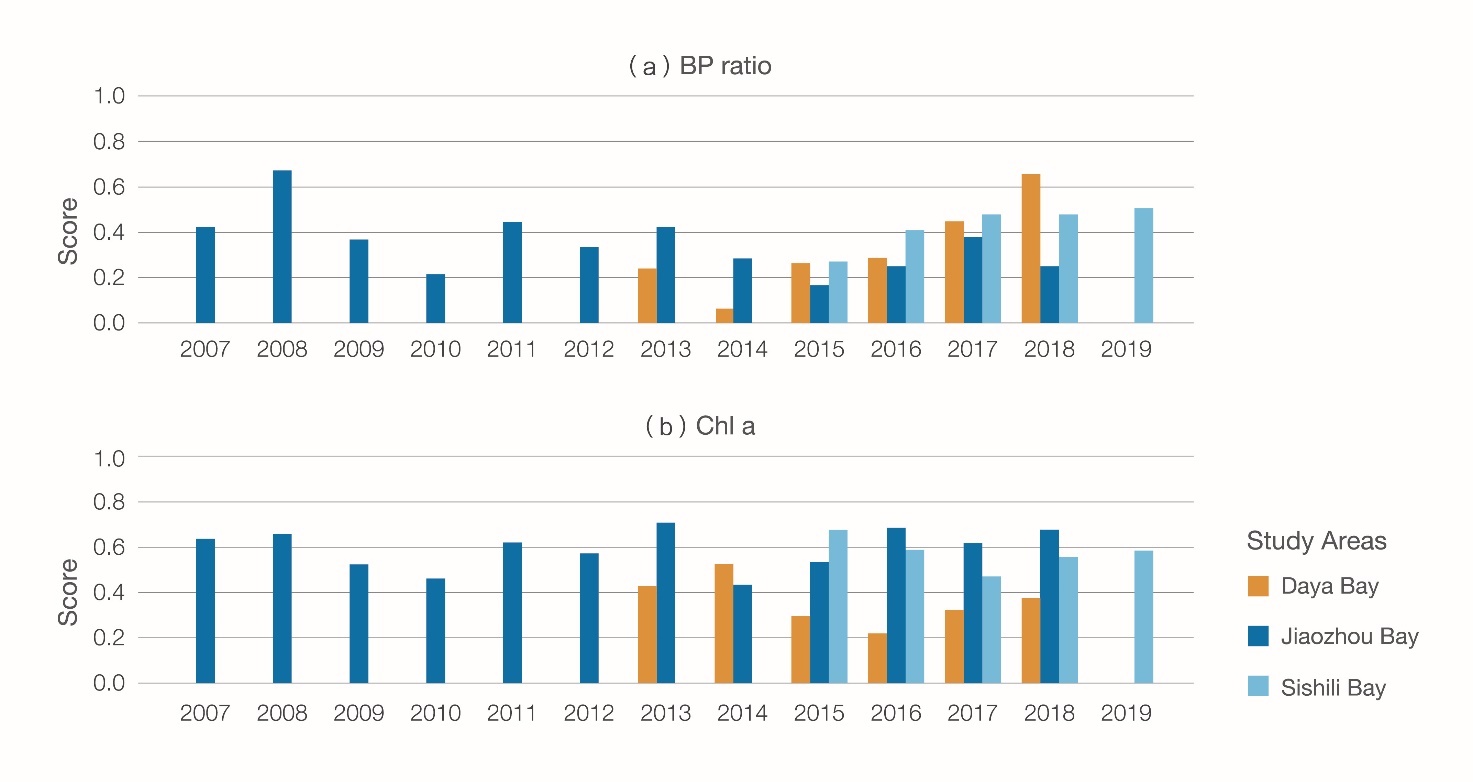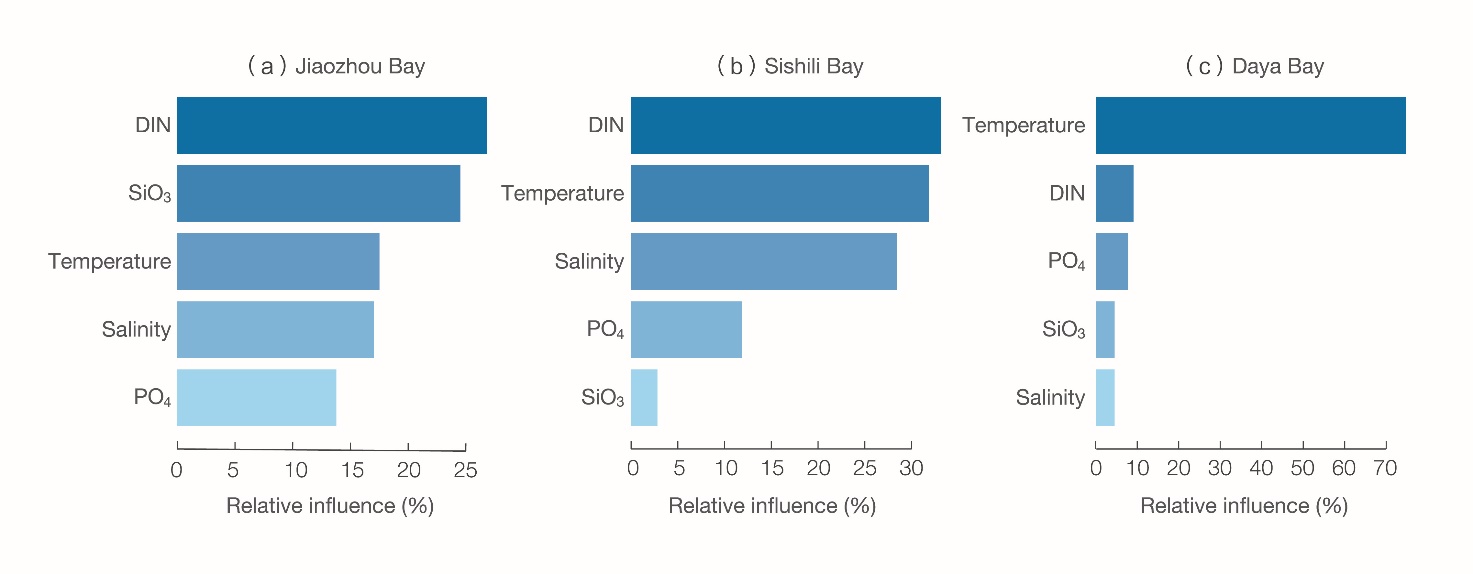Ecosystem health assessment for typical bays in coastal China(2020)
Target 14.2: By 2020, sustainably manage and protect marine and coastal ecosystems to avoid significant adverse impacts, including by strengthening their resilience and take action for their restoration, to achieve healthy and productive oceans.
| Highlights |
| The ecosystems of Jiaozhou Bay, Sishili Bay and Daya Bay are in relatively good health at present, For more than a decade from 2007 to 2019, the overall health of the Jiaozhou Bay ecosystem was stable with some upticks, while that of Sishili Bay and Daya Bay remained stable. The health condition of Daya Bay showed slight improvement from 2016 onward. |
Background
Industry, agriculture, aquaculture, tourism and other human activities bring compounding pressures on global coastal ecosystems. According to SDG Target 14.2 of the UN 2030 Agenda for Sustainable Development, it is time to "sustainably manage and protect marine and coastal ecosystems" and "achieve healthy…oceans". Marine ecosystem health assessments, which are instrumental in ocean governance and the development and use of oceans and seas, provide an important scientific basis for the protection of marine ecosystems and environment and ecological management, and help us move forward on a range of issues related to the marine environment and resources protection (Rapport, 1995; Pollard, 1998).
Data used
◎ Datasets on hydrological, chemical, planktonic, benthic, microbiological and other environmental/ecological factors in the typical bays available on the National Ecosystem Research Network of China (CERN) for the period of January 2007 to December 2019.
Method
Linked to Target 14.2, this study aims to refine the methodology of assessment in light of the characteristics of bay ecosystems, analyze the current state and variation trends of different ecosystem elements, and adjust and select parameters against the SDG indicators; conduct machine learning-enabled data mining to introduce additional threshold criteria or improve existing ones for assessment; and develop a report card assessment model in support of policy-making on coastal ecosystem management.
Results and analysis
For the purposes of this study, Sishili Bay, Jiaozhou Bay and Daya Bay were chosen as typical bays, representing different ecological environments and human activities: Sishili Bay is located in the northern part of the Yellow Sea, and the bay itself and its surrounding areas are home to agriculture, industry, aquaculture, port services and so on, with a high incidence of red tides in the bay; Jiaozhou Bay is located in the southern part of the Yellow Sea and is subjected to a range of anthropogenic stressors, including port services, aquaculture and a long bridge arching over the bay; Daya Bay is located in the South China Sea, home to the Daya Bay Nuclear Power Base with six units in operation. Joint health assessments were used to provide scientific information for the protection and management of different marine areas.
1) A general mapping of the health of typical bay ecosystems
The findings indicate that the ecosystems in Sishili Bay, Jiaozhou Bay and Daya Bay are in good health at present. From 2007 to 2018, the health of the Jiaozhou Bay ecosystem was stable with moderate improvement. The overall ecosystem health of Sishili Bay from 2015 to 2019 and Daya Bay from 2013 to 2018 was stable. Starting in 2016, there was a moderate improvement in the ecosystem health of Daya Bay. The assessment findings are shown in Figure 6-3.
2) Assessment of individual key elements of typical bay ecosystems
The sea surface Chlorophyll a (Chl a) concentration and the ratio between the Bacillariophyta and Pyrrophyta abundance (BP ratio) can respectively represent the primary productivity level and phytoplankton community structure in a given area to some extent and are therefore important indicators of its ecosystem health. We assessed the health of the three typical bays by measuring those two values and the results are as follows: The health of the phytoplankton community structure in Sishili Bay, as indicated by the BP ratio, showed a trend of sustained improvement and its primary productivity remained good and stable. The phytoplankton community structure of Daya Bay improved as from 2014, but its primary productivity was rated the lowest among the three bays, which might be attributable to its nutrient level. Jiaozhou Bay was rated slightly lower than the other two in phytoplankton community structure health while its primary productivity health remained good. See Figure 6-4 for details.
3) An analysis of contribution of environmental factors to changes in key elements of ecosystems
Machine learning was used to study how key environmental factors contributed to the variations in Bacillariophyta abundance in the bays (Fig. 6-5). Higher contribution indicates a greater role in changing Bacillariophyta abundance. The results indicate that the greatest contribution to Bacillariophyta abundance variations came from nutrients in Jiaozhou Bay and Sishili Bay while water temperature was the number one contributing factor to the Bacillariophyta abundance variations in Daya Bay. They are consistent with the characteristics of the three bays studied: In both Jiaozhou Bay and Sishili Bay, the ecological elements were closely correlated with nutrients because of higher concentration of nutrients as a result of significant impacts from human activities such as industry, agriculture and aquaculture. On the other hand, the water temperature variations in Daya Bay contributed the most to changes in Bacillariophyta abundance, probably as a direct consequence of the heated water discharged from the nuclear power plants located around Daya Bay.

Figure 6-3. Ecosystem health mapping results in selected bays 2007-2019

Figure 6-4. Assessment results of key elements of typical bays (Grades and levels as shown in Fig. 6-3)
(a) Bacillariophyta Pyrrophyta ratio (BP ratio); (b) Chlorophyll a (Chl a)

Figure 6-5. Contributions of environmental factors to abundance of Bacillariophyta, a dominant species of phytoplankton
(a) Jiaozhou Bay; (b) Sishili Bay; (c) Daya Bay
Outlook
Using the coastal ecosystem health assessment approach, this study involves a number of assessments jointly conducted in the three typical coastal bays of China, analyzing the current status and variation trends of these coastal ecosystems, comparing their key ecosystem health elements and investigating major contributing factors to changes in the state of marine ecosystems of these bays. The expert diagnostic models will be further refined to make the diagnosis more objective by analyzing the stress factors affecting ecosystem health. Customized decision support systems that include analytical tools catering to different users and use scenarios will also be developed, in support of coastal environment protection and management.

